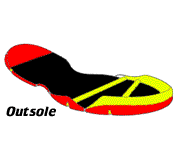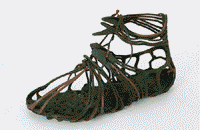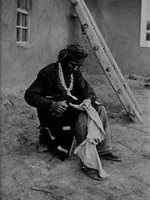Shoe Art & Fashion - Book

Everything about Footwear News and History, Making, Associations, Glossary, Fashion, Podiatry, Publications, Trading.


Place to order this book (from Amazon.com)
 A Century of Shoes: Icons of Style in the 20th Century
A Century of Shoes: Icons of Style in the 20th Century

 Athletic Shoes : Characteristics
Athletic Shoes : CharacteristicsSome Sport Walking Shoes, however, are not well designed. The usually observed flaws are:

 ONE of a pair of very elegant shoes and clogs combined, known also as double-soled shoes, made of white kid leather, which appears to have been covered with cream silk damask. The insteps and toes richly embroidered with pale pink or salmon- coloured silk are powdered with seed pearls; the heels retain traces of pink brocade; the latchets are made for tying, and seem from the fragments remaining to have had a fringe and ruching of pearly grey silk, which divided the shoe across the instep, while below the latchets on the instep flap four holes are punched at regular distances probably as a means of affixing a rosette or bow of ribbon. The heels taper downwards and are 2½ inches high, gaining an additional ½ inch by the thickness of the flat heel of the clog, which with the sole, also flat, is of brown leather. The toes, measuring inches across, are flat and square. The total length of the clogs is 10½ inches, the heels being 1¾ inches wide; though the colours of the brocade are faded, the shoes in other respects are in good condition.
ONE of a pair of very elegant shoes and clogs combined, known also as double-soled shoes, made of white kid leather, which appears to have been covered with cream silk damask. The insteps and toes richly embroidered with pale pink or salmon- coloured silk are powdered with seed pearls; the heels retain traces of pink brocade; the latchets are made for tying, and seem from the fragments remaining to have had a fringe and ruching of pearly grey silk, which divided the shoe across the instep, while below the latchets on the instep flap four holes are punched at regular distances probably as a means of affixing a rosette or bow of ribbon. The heels taper downwards and are 2½ inches high, gaining an additional ½ inch by the thickness of the flat heel of the clog, which with the sole, also flat, is of brown leather. The toes, measuring inches across, are flat and square. The total length of the clogs is 10½ inches, the heels being 1¾ inches wide; though the colours of the brocade are faded, the shoes in other respects are in good condition.As sure as night follows day, the ultimate sexy shoe styles that celebrities are wearing on their feet, (APMA) will be purchased and worn by everyday fashion mavens tomorrow. But sporting the hottest shoe fashion often requires more than just a monetary sacrifice, as evidenced by a recent survey conducted by the American Podiatric Medical Association (APMA) stating that 82% of women say they are willing to sacrifice the health of their feet for fashion.


Why ?
Solution
” says APMA member Dr. Jane Andersen. “Wearing fashionable shoes doesn’t have to result in pain and discomfort. If you understand how an ill-fitting shoe can negatively impact your foot, in the end you’ll be able to purchase shoes this season that are both sensible and stylish.”
 Jennifer Aniston : is an American actress, born February 11, 1969, is an Emmy and Golden Globe-winning American film and television actress. best known for playing Rachel Green on the television sitcom Friends.
Jennifer Aniston : is an American actress, born February 11, 1969, is an Emmy and Golden Globe-winning American film and television actress. best known for playing Rachel Green on the television sitcom Friends.
Why?
Solution
*Read more articles at APMA*
There are eight colleges of podiatric medicine in the United States. They all receive accreditation from the Council on Podiatric Medical Education, which is recognized by the U.S. Secretary of Education and the Council on Higher Education Accreditation. All of the colleges grant the degree of Doctor of Podiatric Medicine (DPM). Students who are interested in attending a college of podiatric medicine can contact any of the colleges directly for more information.Approximately 95% of all first-year students entering the colleges of podiatric medicine possess baccalaureate degrees and about 10% have advanced degrees. As with institutions granting MD and DO degrees, the colleges may consider candidates who show unusual promise and have completed a minimum of 90 semester hours at accredited undergraduate colleges or universities. Applicants for admission are also required to complete the Medical College Admission Test (MCAT) as a prerequisite, although some of the colleges accept the Graduate Record Examination (GRE) as well.Candidates for podiatric medical schools can apply online by contacting the American Association of Colleges of Podiatric Medicine at www.aacpm.org. In addition, the AACPM has a mentor network that matches students interested in podiatric medicine to podiatrists in their area.
 Designers began to experiment with shoe fashion. Platform shoes made their first 20th century appearance in the late 1930s. Created by designers such as Salvatore Ferragamo and André Perugia, these platforms were created from wood, cork and other materials, due to a shortage of leather and a war ban on rubber.
Designers began to experiment with shoe fashion. Platform shoes made their first 20th century appearance in the late 1930s. Created by designers such as Salvatore Ferragamo and André Perugia, these platforms were created from wood, cork and other materials, due to a shortage of leather and a war ban on rubber.NEW YORK (December 8, 2006) - Puma and the Cameroon Football Association have entered into a long-term extension of their partnership.
 The main function of the outsole is to provide traction as well as to reduce wear on the midsole thereby increasing the overall durability of the shoe.
The main function of the outsole is to provide traction as well as to reduce wear on the midsole thereby increasing the overall durability of the shoe. Traction - As mentioned earlier how well a shoe needs to grip depends on the sporting event. A cross country runner might need a different shoe on a rainy day than they would need on a hard compacted surface. A basketball player needs an outsole that will grip well when running, but not when they are pivoting. A basketball player also needs a shoe that will not stop them so suddenly, or grab, when the are trying to stop as this can cause them to turn there ankle and injure themselves. The traction properties of a shoe, really a measure of the friction between the outsole and the playing surface, are directly related to the materials used in the outsoles construction as well as the pattern on the outsole.
Traction - As mentioned earlier how well a shoe needs to grip depends on the sporting event. A cross country runner might need a different shoe on a rainy day than they would need on a hard compacted surface. A basketball player needs an outsole that will grip well when running, but not when they are pivoting. A basketball player also needs a shoe that will not stop them so suddenly, or grab, when the are trying to stop as this can cause them to turn there ankle and injure themselves. The traction properties of a shoe, really a measure of the friction between the outsole and the playing surface, are directly related to the materials used in the outsoles construction as well as the pattern on the outsole.
 Getting Cultural History under One’s Skin :
Getting Cultural History under One’s Skin :This Glossary attempts to define the more commonly used terminology. A
 Four thousand years ago, the ancestors of the Pueblo farmers began planting corn and living in large dwellings built from stone and adobe bricks (sun dried clay). Spanish explorers arrived in 1539 and named the local people Pueblos after the Spanish word for "village". At that time, the Natives had settled villages and could grow crops by using irrigation, which yielded a plentiful and dependable food supply. They kept a two to three year supply of dried food and grain stored so they would not go hungry if a drought came. To supplement their crops, the men of the village often held hunts, adding deer, antelope and rabbit meat to their diet.
Four thousand years ago, the ancestors of the Pueblo farmers began planting corn and living in large dwellings built from stone and adobe bricks (sun dried clay). Spanish explorers arrived in 1539 and named the local people Pueblos after the Spanish word for "village". At that time, the Natives had settled villages and could grow crops by using irrigation, which yielded a plentiful and dependable food supply. They kept a two to three year supply of dried food and grain stored so they would not go hungry if a drought came. To supplement their crops, the men of the village often held hunts, adding deer, antelope and rabbit meat to their diet. inhabited communities in North America. The Zuni whose name means "people of the town" established their villages on high, flat-topped mesas and are descendants of the Anasazi.
inhabited communities in North America. The Zuni whose name means "people of the town" established their villages on high, flat-topped mesas and are descendants of the Anasazi.
 Evidence from prehistoric cultures of the Southwest dates back eleven thousand years. Examples of basketry and sandals have been scientifically dated as far back as eight thousand six hundred years. These have been found in sites with hard-beaten earthen floors and storage pits, which indicate a domestic lifestyle. From about four thousand years ago the development of agriculture supplied these cultures with corn, beans and squash as cultivated agricultural diet staples.
Evidence from prehistoric cultures of the Southwest dates back eleven thousand years. Examples of basketry and sandals have been scientifically dated as far back as eight thousand six hundred years. These have been found in sites with hard-beaten earthen floors and storage pits, which indicate a domestic lifestyle. From about four thousand years ago the development of agriculture supplied these cultures with corn, beans and squash as cultivated agricultural diet staples. culture of the Southwest, and, along with the Hohokam and Mogollon cultures, the most influential. They lived in large groups in caves and cliff-dwelling villages. Some multi-dwelling residences were so large that they were not eclipsed in size in North America until an apartment building was erected in New York in 1882.
culture of the Southwest, and, along with the Hohokam and Mogollon cultures, the most influential. They lived in large groups in caves and cliff-dwelling villages. Some multi-dwelling residences were so large that they were not eclipsed in size in North America until an apartment building was erected in New York in 1882. period is so called for the refined ceramics and clay dwellings that were created and perfected at this time. A prolonged regional drought (1276 - 1299) combined with overcrowding, depletion of resources (wood and soil) and warring with neighbouring groups, led to their demise and
period is so called for the refined ceramics and clay dwellings that were created and perfected at this time. A prolonged regional drought (1276 - 1299) combined with overcrowding, depletion of resources (wood and soil) and warring with neighbouring groups, led to their demise and
That the average person walks 2,000 miles a year.
